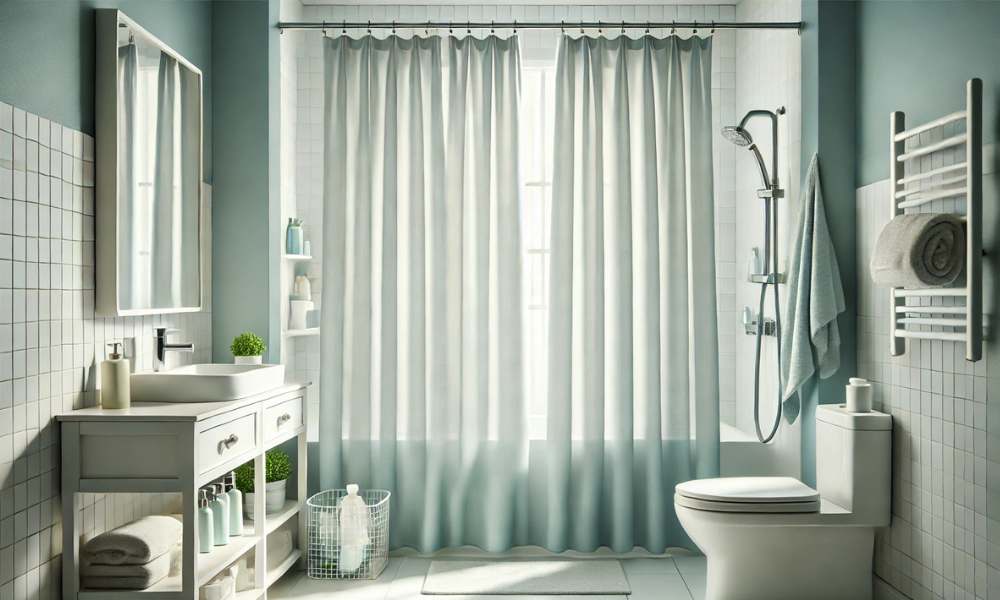Shower curtains are a vital part of maintaining a clean and hygienic bathroom. But how often should shower curtains be replaced to keep your space fresh? Experts recommend replacing shower curtains every 6 to 12 months, depending on wear and tear, or sooner if mold and mildew appear. Regular cleaning can extend their lifespan, but knowing when to switch them out ensures a healthier environment. Opt for machine-washable or eco-friendly materials to make replacements hassle-free. Keeping a schedule for replacing shower curtains is key to preventing bathroom odors and unsightly stains. Stay proactive in maintaining your bathroom’s cleanliness by refreshing your shower curtain at the right time!
Understanding Shower Curtains

A shower curtain does more than just block water from escaping your bathtub or stall. It’s a delicate interplay between practicality and design. Available in a myriad of materials—vinyl, polyester, cotton, and even hemp they reflect both your taste and your tolerance for upkeep. Yet, with all their aesthetic allure, their environment is hostile: high humidity, constant exposure to wetness, and contact with soap and shampoo residues. Over time, even the sturdiest curtain succumbs to the rigors of its role.
Understanding The Lifespan Of Shower Curtains

Not all shower curtains are created equal. Some, like plastic liners, are budget-friendly but fleeting, lasting anywhere from 6 to 12 months. Fabric shower curtains be replaced, treated with water-repellent or mildew-resistant coatings, often endure longer—up to two years with meticulous care. But these are averages. Factors such as how frequently they’re used, the bathroom’s ventilation, and the owner’s cleaning habits can drastically alter this timeline.
Factors Affecting How Often Shower Curtains Need Replacement

- Material Matters Plastic liners degrade quickly under the assault of humidity and soap residue. In contrast, fabric curtains, though costlier, are more resilient when paired with regular cleaning.
- Frequency of Use A bustling household with multiple daily showers accelerates wear and tear. Conversely, a guest bathroom curtain might last much longer.
- Ventilation Bathrooms with poor airflow are a paradise for mold and mildew, shortening a curtain’s lifespan significantly.
- Maintenance Routine A neglected curtain, caked with soap scum and grime, is a recipe for replacement. Regular upkeep makes all the difference.
The Importance Of Replacing Shower Curtains For A Clean Bathroom

A neglected shower curtain isn’t just an eyesore—it’s a health hazard. Over time, mold and mildew colonize the surface, releasing spores into the air. These invisible invaders can trigger respiratory issues, allergies, and skin irritations. Moreover, the stains and odors from an overused long are shower curtains create an unpleasant environment that no amount of air freshener can mask.
Preventing Early Wear And Tear On Your Shower Curtain

- Let It Breathe: After each use, spread the curtain wide to prevent moisture from lingering in the folds.
- Layer Up: Use a protective liner to shield the main curtain from direct exposure to water.
- Mind Your Cleaners: Harsh chemicals erode materials. Stick to gentle, non-abrasive cleaning agents.
Signs It’s Time To Replace Your Shower Curtain

- Mold and Mildew Overload If black spots stubbornly return after cleaning, it’s time to let go.
- Discoloration Yellowing or fading that persists despite your best scrubbing efforts signals irreversible damage.
- Tears and Frays Ripped edges and thinning sections compromise the curtain’s functionality.
- Lingering Smell A musty odor that defies washing is a surefire sign of deeply embedded mold.
What Affects Shower Curtain Longevity?
The water in your home plays a sneaky role—hard water, with its high mineral content, leaves behind stubborn deposits. Excessive humidity hastens mildew growth, while constant tugging or improper handling wears down seams. Even something as simple as the height at which you hang the curtain impacts how often it rubs against the floor, accelerating wear.
The Role Of Mold And Mildew In Shower Curtain Lifespan

Mold is the bane of bathroom life. It’s not just unsightly; it’s a persistent invader. Vinyl shower curtains be replaced, in particular, are highly prone to mildew because they lack the breathability of fabrics. Once mold embeds itself in the material, it’s nearly impossible to eradicate fully. Keeping a vigilant eye and acting at the first sign of growth is key to longevity.
Cleaning And Maintaining Shower Curtains To Extend Their Life
- Weekly TLC A quick rinse with warm water and a swipe with a sponge can prevent grime buildup.
- Monthly Deep Clean For fabric curtains, toss them into the washing machine with a mild detergent. Plastic curtains benefit from a soak in vinegar or baking soda solutions.
- Spot Treatment for Stubborn Stains Mix baking soda with water to create a paste and gently scrub affected areas.
Choosing Sustainable Materials For A Longer-Lasting Curtain
Eco-conscious choices like hemp and organic cotton not only last longer but are also biodegradable. Unlike plastic options, they don’t release harmful chemicals into your home. Additionally, these materials often come treated with natural mold inhibitors, making them both durable and environmentally friendly.
Common Mistakes To Avoid With Shower Curtain Care
- Letting It Stay Wet A damp, crumpled curtain is a mold magnet. Always ensure it dries fully.
- Skipping Liners A liner absorbs the brunt of water exposure, shielding the outer curtain.
- Ignoring Ventilation Ventilation is non-negotiable. Install a fan or open a window after every shower.
Cleaning And Maintenance Tips To Extend Shower Curtain Lifespan
- Salt Treatment: A soak in salty water before the first use discourages mold growth.
- Use Dehumidifiers: These devices pull excess moisture from the air, creating a hostile environment for mold.
- Frequent Liner Replacements: Liners are inexpensive and easy to replace, protecting the more costly outer curtain.
Frequently Asked Questions
– When Should I Replace My Shower Curtain?
You should replace your shower curtain when it shows signs of mold, mildew, or stubborn stains that won’t come off despite cleaning. If it starts to smell musty, becomes torn, or loses its waterproofing, it’s time for a new one.
– How Often Should I Replace My Shower Curtain?
Replace your shower curtain every 6 to 12 months to maintain cleanliness and hygiene. However, this can vary based on usage and how well you clean it. Regular washing can extend its lifespan, but don’t wait too long to replace it when needed.
Final Thoughts
Understanding how often shower curtains should be replaced ensures a clean and hygienic bathroom. Ideally, replace them every 6-12 months, depending on wear and tear, mold growth, or stubborn stains. Regular cleaning can extend their lifespan, but don’t compromise on health or aesthetics. Opt for washable or mildew-resistant curtains to maintain freshness longer. Keeping track of your shower curtain’s condition is a small step toward a healthier home. Prioritize timely replacement to enjoy a clean, inviting bathroom environment!
